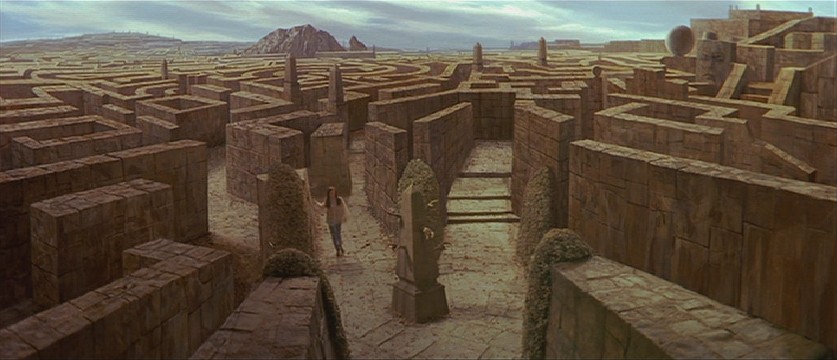
Labyrinths, mazes etc.

Platform.--This was a framework a hundred feet long and twelve wide, a ship's deck in fact, with a projecting prow. Beneath was a hull solidly built, enclosing the engines, stores, and provisions of all sorts, including the watertanks. Round the deck a few light uprights supported a wire trellis that did duty for bulwarks. On the deck were three houses, whose compartments were used as cabins for the crew, or as machine rooms. In the center house was the machine which drove the suspensory helices, in that forward was the machine that drove the bow screw, in that aft was the machine that drove the stern screw. In the bow were the cook's galley and the crew's quarters; in the stern were several cabins, including that of the engineer, the saloon, and above them all a glass house in which stood the helmsman, who steered
the vessel by means of a powerful rudder. All these cabins were lighted by port-holes filled with toughened glass, which has ten times the resistance of ordinary glass. Beneath the hull was a system of flexible springs to ease off the concussion when it became advisable to land.
Engines of suspension and propulsion.--Above the deck rose thirty-seven vertical axes, fifteen along each side, and seven, more elevated, in the centre. The Albatross" might be called a clipper with thirty-seven masts. But these masts instead of sails bore each two horizontal screws, not very large in spread or diameter, but driven at prodigious speed. Each of these axes had its own movement
independent of the rest, and each alternate one spun round in a different direction from the others, so as to avoid any tendency to gyration. Hence the screws as they rose on the vertical column of air retained their equilibrium by their horizontal resistance. Consequently the apparatus was furnished with seventy-four suspensory
screws, whose three branches were connected by a metallic circle which economized their motive force. In front and behind, mounted on horizontal axes, were two propelling screws, each with four arms. These screws were of much larger diameter than the suspensory ones, but could be worked at quite their speed. In fact, the vessel combined the systems of Cossus, La Landelle, and Ponton d'Am�court, as perfected by Robur. But it was in the choice and application of his motive force that he could claim to be an inventor.
Perhaps I can best describe my experience of doing mathematics in terms of a journey through a dark unexplored mansion. You enter the first room of the mansion and it's completely dark. You stumble around bumping into the furniture, but gradually you learn where each piece of furniture is. Finally, after six months or so, you find the light switch, you turn it on, and suddenly it's all illuminated. You can see exactly where you were. Then you move into the next room and spend another six months in the dark.